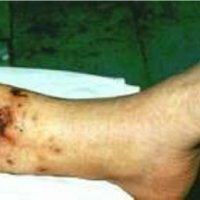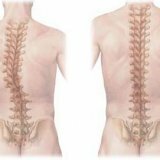Trophic ulcers of lower leg

Trophic ulcers, formed in the region of the lower leg, are not an independent disease. They are formed as a complication in the following diseases: chronic venous insufficiency( postthrombophlebitic disease, varicose disease);Chronic arterial insufficiency( obliterating thromboangiitis, atherosclerosis, nonspecific aortoarteritis).Also, peripheral polyneuropathies of the extremities, etc. These shin ulcers mainly arise due to chronic venous insufficiency.
What are the causes of ulceration of the shin?
Disturbance of blood supply in a separate area of the skin leads to the appearance of microcirculation disorders, lack of nutrients and oxygen, as well as to serious metabolic disturbances in tissues. A patch of skin that is affected is necrotic and becomes particularly sensitive to various trauma agents, as well as infection attachment.
What are the symptoms of trophic leg ulcers?
First the skin on the anterior third of the leg( lower part) is thinned. She becomes tense, dry, shiny. The skin develops characteristic pigment spots, after a small ulcer appears, which slowly increases. The edges of the ulcer thicken, and the bottom is covered with bloom and bleeds. In the future, even with any minimal trauma, an ulcerative defect is widening and an infection is attached. The main complaint of patients is pain. The presence of a defect in the skin prevents a person from correctly picking up clothes and shoes, respecting personal hygiene.
Local purulent processes that are associated with the formation of furuncles, precede the formation of trophic ulcers of the shin. Trophic changes gradually increase in the skin and the destruction of tissues becomes extensive. The expanding and deepening manifestations are replaced by granulation.
Often, the development of the disease leads to a sufficient increase in the ulcer surface, which covers the whole shin. The shape of the affected area is oval or round. The ulcer itself has a gentle edge.
The granulation remains on the bottom of the ulcer, and the bubbles have a cyanotic color with a gray bloom. The color of the granulation differs in the "purulent" shade. Ulcer exudes a bad smell, which indicates a purulent process, coupled with the death of tissues. The ulcer acquires a brown color as it develops.
The course of this disease is long enough, with frequent relapses. Only trophic ulcers begin to heal because of prolonged treatment, as a new minor injury gives a relapse. These relapses are provoked by congestion in the veins that result from a long stay on the "feet" or a long walk. Therefore, it is incredibly difficult to achieve complete cure of trophic ulcers of the lower leg.
Diagnosis and treatment of trophic ulcers of the lower leg
To diagnose trophic ulcers, it is necessary to establish the cause of the disease. The ultrasound doplerography of the vessels of the legs is performed for diagnosis. Also percutaneous measurement of oxygen level, radiopaque phlebography and other studies of limb blood flow.
Venous trophic ulcers are characterized by a recurrent long-term course. The optimal tactic of treatment of trophic ulcers of the lower leg is aimed at closing these ulcers with the help of a conservative method of treatment followed by surgical intervention on the venous system.
The state of the patient depends on where the treatment of the disease will be performed - at home, in the hospital, or on an outpatient basis. Local treatment of the disease includes the following activities. This is a daily toilet of the ulcerous surface with the help of sponges or napkins with antiseptic solutions;Overlapping bandages with healing ointments, as well as wearing an elastic band( this is a bandage of elastic bandage);Reception of medications that promote the healing of shin ulcers. These are such drugs as, Vulnuzan, Actovegin, Biopin, Gepatrombin, Cliotex, D-Panthenol, Depantol, Dolobene. Also Geparoid Zentiva, Sylvederm, Sulfargin, Trombless, Metrogil, Elma, etc. It is necessary to know in order to prevent a relapse of the disease, with the healing of ulcers, it is necessary to protect the scars reliably from possible traumatization.



